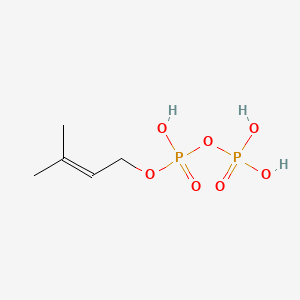| MeSH term | MeSH ID | Detail |
|---|---|---|
| Melanoma | D008545 | 69 associated lipids |
Dimethylallyl pyrophosphate
Dimethylallyl pyrophosphate is a lipid of Prenol Lipids (PR) class. Dimethylallyl pyrophosphate is associated with abnormalities such as Consumption-archaic term for TB and Wiskott-Aldrich Syndrome. The involved functions are known as Anabolism, Biochemical Pathway, Oxidation, Process and Chelating Activity [MoA]. Dimethylallyl pyrophosphate often locates in Chloroplasts, Plastids, chloroplast stroma, Cytosol and Cell membrane. The associated genes with Dimethylallyl pyrophosphate are IRF6 wt Allele and ADRBK1 gene. The related lipids are Sterols.
Cross Reference
Introduction
To understand associated biological information of Dimethylallyl pyrophosphate, we collected biological information of abnormalities, associated pathways, cellular/molecular locations, biological functions, related genes/proteins, lipids and common seen animal/experimental models with organized paragraphs from literatures.
What diseases are associated with Dimethylallyl pyrophosphate?
Dimethylallyl pyrophosphate is suspected in and other diseases in descending order of the highest number of associated sentences.
Related references are mostly published in these journals:
| Disease | Cross reference | Weighted score | Related literature |
|---|
Possible diseases from mapped MeSH terms on references
We collected disease MeSH terms mapped to the references associated with Dimethylallyl pyrophosphate
PubChem Associated disorders and diseases
What pathways are associated with Dimethylallyl pyrophosphate
Lipid pathways are not clear in current pathway databases. We organized associated pathways with Dimethylallyl pyrophosphate through full-text articles, including metabolic pathways or pathways of biological mechanisms.
Related references are published most in these journals:
| Pathway name | Related literatures |
|---|
PubChem Biomolecular Interactions and Pathways
Link to PubChem Biomolecular Interactions and PathwaysWhat cellular locations are associated with Dimethylallyl pyrophosphate?
Visualization in cellular structure
Associated locations are in red color. Not associated locations are in black.
Related references are published most in these journals:
| Location | Cross reference | Weighted score | Related literatures |
|---|
What functions are associated with Dimethylallyl pyrophosphate?
Related references are published most in these journals:
| Function | Cross reference | Weighted score | Related literatures |
|---|
What lipids are associated with Dimethylallyl pyrophosphate?
Related references are published most in these journals:
| Lipid concept | Cross reference | Weighted score | Related literatures |
|---|
What genes are associated with Dimethylallyl pyrophosphate?
Related references are published most in these journals:
| Gene | Cross reference | Weighted score | Related literatures |
|---|
What common seen animal models are associated with Dimethylallyl pyrophosphate?
There are no associated biomedical information in the current reference collection.
NCBI Entrez Crosslinks
All references with Dimethylallyl pyrophosphate
Download all related citations| Authors | Title | Published | Journal | PubMed Link |
|---|---|---|---|---|
| Jost M et al. | Structure-function analysis of an enzymatic prenyl transfer reaction identifies a reaction chamber with modifiable specificity. | 2010 | J. Am. Chem. Soc. | pmid:21105662 |
| Li Z et al. | Effect of temperature on postillumination isoprene emission in oak and poplar. | 2011 | Plant Physiol. | pmid:21177471 |
| pmid:21199890 | ||||
| Yu Q et al. | Plant carotene cis-trans isomerase CRTISO: a new member of the FAD(RED)-dependent flavoproteins catalyzing non-redox reactions. | 2011 | J. Biol. Chem. | pmid:21209101 |
| Mann FM et al. | Rv0989c encodes a novel (E)-geranyl diphosphate synthase facilitating decaprenyl diphosphate biosynthesis in Mycobacterium tuberculosis. | 2011 | FEBS Lett. | pmid:21237161 |
| Meraviglia S et al. | γδ T cells cross-link innate and adaptive immunity in Mycobacterium tuberculosis infection. | 2011 | Clin. Dev. Immunol. | pmid:21253470 |
| Ignea C et al. | Improving yeast strains using recyclable integration cassettes, for the production of plant terpenoids. | 2011 | Microb. Cell Fact. | pmid:21276210 |
| Seeger K et al. | The biosynthetic genes for prenylated phenazines are located at two different chromosomal loci of Streptomyces cinnamonensis DSM 1042. | 2011 | Microb Biotechnol | pmid:21342470 |
| Heaps NA and Poulter CD | Synthesis and evaluation of chlorinated substrate analogues for farnesyl diphosphate synthase. | 2011 | J. Org. Chem. | pmid:21344952 |
| Su YH et al. | Auxin-cytokinin interaction regulates meristem development. | 2011 | Mol Plant | pmid:21357646 |
| Kiran U et al. | Structural and functional characterization of HMG-COA reductase from Artemisia annua. | 2010 | Bioinformation | pmid:21364776 |
| Cantagrel V and Lefeber DJ | From glycosylation disorders to dolichol biosynthesis defects: a new class of metabolic diseases. | 2011 | J. Inherit. Metab. Dis. | pmid:21384228 |
| Ghirardo A et al. | Biogenic volatile organic compound and respiratory CO2 emissions after 13C-labeling: online tracing of C translocation dynamics in poplar plants. | 2011 | PLoS ONE | pmid:21387007 |
| Zhong YJ et al. | Functional characterization of various algal carotenoid ketolases reveals that ketolating zeaxanthin efficiently is essential for high production of astaxanthin in transgenic Arabidopsis. | 2011 | J. Exp. Bot. | pmid:21398427 |
| Dunne MR et al. | Preferential Th1 cytokine profile of phosphoantigen-stimulated human Vγ9Vδ2 T cells. | 2010 | Mediators Inflamm. | pmid:21403900 |
| Atsbaha Zebelo S et al. | Chrysolina herbacea modulates terpenoid biosynthesis of Mentha aquatica L. | 2011 | PLoS ONE | pmid:21408066 |
| pmid:21468716 | ||||
| Gray DW et al. | Biochemical characterization and homology modeling of methylbutenol synthase and implications for understanding hemiterpene synthase evolution in plants. | 2011 | J. Biol. Chem. | pmid:21504898 |
| Zhou K et al. | Novel reference genes for quantifying transcriptional responses of Escherichia coli to protein overexpression by quantitative PCR. | 2011 | BMC Mol. Biol. | pmid:21513543 |
| Lemuth K et al. | Engineering of a plasmid-free Escherichia coli strain for improved in vivo biosynthesis of astaxanthin. | 2011 | Microb. Cell Fact. | pmid:21521516 |
